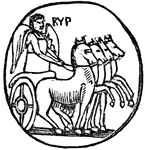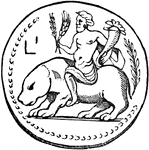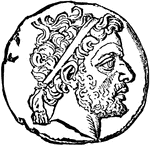This Greek ClipArt gallery offers 87 illustrations of historic coins of Greece.

Medal of Damascus
A medal of Damascus, showing the turreted goddess holding out her right hand, a cornucopia in her left,…

Medal of Dor
A medal showing Astarte on one side, who was worshiped in Dor as the principle of fertility. The other…

Medal of Gaza
Another medal of Gaza. On one side it shows the head of Emperor Commodus, with his name inscribed. The…

Medal of Melita
A medal engraved with the portrait of Melita; the reverse side depicting a figure with two sets of wings…

Medal of Smyrna
A medal of Smyrna depicting Ceres, the goddess of plenty. The reverse side of the medal shows Jupiter…

Medal of Tyre
A medal of Tyre, depicting the Tyrians presenting a plan of their city to Dido, the Queen of Carthage.…

Medal with Heads
A medal containing two circles of heads, each having seven, male and female alike. The heads of the…
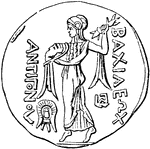
Coin of Minerva
"Minerva is often represented on gems and coins, hurling the thunderbolts of Jove. The following cut,…

Obolus
"A small coin of ancient Greece, in later times of silver, the sixth part of an Attic drachma, equal…

Parthia
The head engraved on one side of the coin is thought to be the portraits of the king of Parthia. In…
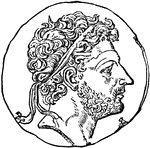
Perseus of Macedonia Coin
An illustration of a coin with the face of Perseus of Macedonia. Perseus the legendary founder of Mycenae…
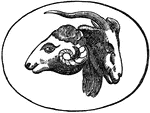
Persia and Macedonia
Cut from an ancient stone, the ram and goat with one horn are symbols for Persia and Macedonia, respectively.…
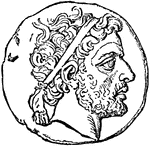
Philip V of Macedonia Coin
An illustration of a coin with the face of Philip V of Macedonia. Philip V was King of Macedonia from…

Puteal
"Puteal, properly means the enclosure surrounding the opening of a well, to protect persons from falling…
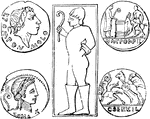
Sculpture and coins
"The figure in the middle of the following illustration is from a most ancient specimen of Etruscan…
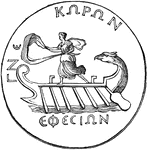
Venus
A marine representation of Venus, the goddess of love and favorable voyages, revered by Ephesus. The…
